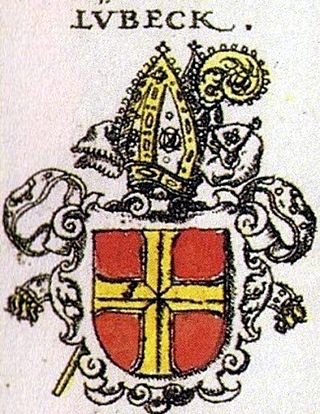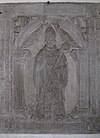Loading AI tools
From Wikipedia, the free encyclopedia
The following persons were Bishops of the Diocese of Oldenburg or Lübeck (until 1180), Prince-Bishops of the diocese of Lübeck and the Prince-Bishopric of Lübeck (1180–1535), Lutheran Administrators of the Prince-Bishopric of Lübeck without pastoral function, and pastoral chairmen of the Evangelical Lutheran State Church in the Region of Lübeck.

Not all incumbents of the Lübeck See were imperially invested princely power as Prince-Bishops and not all were papally confirmed as bishops. In 1180 part of the Lübeck diocesan territory were disentangled from the Duchy of Saxony and became an own territory of imperial immediacy called Prince-Bishopric of Lübeck, a vassal of the Holy Roman Empire. The prince-bishopric was an elective monarchy, with the monarch being the respective bishop usually elected by the Lübeck cathedral chapter, and confirmed by the Holy See, or exceptionally only appointed by the Holy See. Papally confirmed bishops were then invested by the emperor with the princely regalia, thus the title prince-bishop. However, sometimes the respective incumbent of the see never gained a papal confirmation, but was still invested the princely regalia. Also the opposite occurred with a papally confirmed bishop, never invested as prince. A number of incumbents, elected by the chapter, neither achieved papal confirmation nor imperial investiture, but as a matter of fact nevertheless de facto held the princely power. The respective incumbents of the see bore the following titles:
| Bishops | Life | Reign | Notes | Image | Coat-of-arms |
|---|---|---|---|---|---|
| Bishops of Oldenburg (Aldinborg/Starigard) | |||||
| Mareus | 952–968 | also Marcus, Marko | |||
| Ekward | 968–974 | ||||
| Wago | 974–983 | ||||
| Egizo | 983–988 | ||||
| Volkward | 989–990 | ||||
| Reginbert | 992–1013 | ||||
| Bernard | 1013–1023 | German: Bernhard | |||
| Reynald | 1023–1030 | German: Reinhold | |||
| Meinher | 1030–1038 | ||||
| Abelin | 1038–1048 | ||||
| Ehrenfried | 1051–1066 | ||||
| sede vacante | 1066–1149 | ||||
| Vicelinus | ca. 1090–1154 | 1149–1154 | After Oldenburg's destruction by the Danes in 1149 the see provisionally moved to St. Peter's Church in Bosau, built in 1151 |  |
|
| Gerald of Oldenburg (Lübeck) | 1155–1163 | In 1156 Gerald started the construction of St. John's Cathedral in Oldenburg. In 1160 the see moved to Lübeck | |||
| Bishops | Life | Reign | Notes | Image | Coat-of-arms |
|---|---|---|---|---|---|
| Bishops of Lübeck | |||||
| Gerald of Oldenburg (Lübeck) | 1155–1163 | In 1156 Gerald started the construction of St. John's Cathedral in Oldenburg. In 1160 the see moved to Lübeck | |||
| Conrad of Riddagshausenas Conrad I | 1164–1172 | under his reign Lübeck's St. Peter's Church, the city's second main church, was established | |||
| Henry of Brusselsas Henry I | 1172–1182 | on his Holy Orders Duke Henry the Lion laid the cornerstone for the Lübeck Cathedral | |||
| Catholic Prince-Bishops of Lübeck (1180–1535) | |||||
|---|---|---|---|---|---|
| Prince-Bishops | Life | Reign | Notes | Image | Coat-of-arms |
| Henry of Brusselsas Henry I | 1172–1182 | on his Holy Orders Duke Henry the Lion laid the cornerstone for the Lübeck Cathedral | |||
| Conrad II | 1183–1184 | ||||
| Theodoric I | 1186–1210 | German: Dietrich I. | |||
| Bertold | 1210–1230 | German: Berthold | |||
| John I | 1230/1231–1247 | German: Johannes I. | |||
| Albert Suerbeeras Albert I | b. ca. 1200 | 1247–1253 | before Archbishop of Armagh (1240–1246), Administrator of the Diocese of Chiemsee (1246–1247), later Prince-Archbishop of Riga (1253–1273) | ||
| John of Diestas John II | 1254–1259 | German: Johannes II., also Dyst or Deest, d. 21 September 1259 | |||
| John of Tralauas John III | 1260–1276 | German: Johannes III., also Tralowe, d. 4 January 1276; Rudolph I, King of the Germans invested him with the princely regalia for the prince-bishopric, founder of the prince-episcopal castle in Eutin | |||
| Burkhard of Serkem | b. ca. 1236 | 1276–1317 | double tomb with Johannes Mul (1341–50) |  |
|
| Heinrich Bochholtas Henry II | 1317–1341 |  |
|||
| Johannes Mulas John IV | b. ca. 1291 | 1341–1350 | German: Johannes IV., also Muel or Muhl; double tomb with Burkhard of Serkem (1341–1350) |  |
|
| Bertram Cremon | 1350–1377 | d. 5 January 1377 |  |
||
| Nicolaus Vollkrathenas Nicholas I | ?–1392 | 1377–1379 | German: Nikolaus I., also named Ziegenbock, since 1379 Bishop of Meissen | ||
| Conrad of Geisenheimas Conrad III | 1379–1386 | also Gysenheim, Giesenheim, Beymondi; b. in Geisenheim, d. 30 May 1386 in Lübeck. | |||
| John of Klenedenstas John V | 1386–1387 | German: Johannes V., also Clendenst, Kleendienst, or Kleindienst, b. in Lübeck, d. 3 August 1387 ibidem. | |||
| Eberhard Attendornas Eberhard I | 1387–1399 | also Everhardus de Atendorn, Evert von Attenderen, Athendorn; b. in Lübeck, d. on 21 March 1399. | |||
| Johann Hundebekeas John VI | 1399–1420 | German: Johannes VI., also Dülmen, Johann Dulmen, b. in Dülmen, d. 1 January 1420 in Lübeck | |||
| Johannes Scheleas John VII | b. ca. 1385/1390 | 1420–1439 | German: Johannes VII. | ||
| Nicolaus Sachauas Nicholas II | b. ca. 1385 | 1439–1449 | German: Nikolaus II., also Czachow | ||
| Arnold Westphal | b. 1399 | 1450–1466 | |||
| Albert Krummendiekas Albert II | b. 1417/1418 | 1466–1489 | also Krummediek; donated the triumphal cross created by Bernt Notke in the Lübeck Cathedral in 1477 |  |
|
| Thomas Grote | b. ca. 1425 | 1489–1492 | |||
| Dietrich Arndesas Theodoric II | b. 1442 | 1492–1506 | also Diderich Arnd, Theodorich Arndes, Arends | ||
| Wilhem Westphal | b. 1443 | 1506–1509 | |||
| Johannes Grimholtas John VIII | ca. 1450 | 1510–1523 | German: Johannes VIII., also Grymmolt or Grymmelt |  |
|
| Heinrich Bockholtas Henry III | b. 1463 | 1523–1535 | also Bokholt, Bokhold, Buchholtz; since 1531 the Free City of Lübeck adopted Lutheranism and inhibited Catholic pastoring in its part of the Lübeck diocese |  |
|
| Catholic and Lutheran Prince-Bishops of Lübeck (1535–1586) | |||||
|---|---|---|---|---|---|
| Prince-Bishops | Life | Reign | Notes | Image | Coat-of-arms |
| Detlev von Reventlow | b. ca. 1485 | 1535–1535 | also Ditlev; first Lutheran prince-bishop, started the Protestant Reformation in the diocese of Lübeck | ||
| Balthasar Rantzau | ca. 1497 | 1536–1547 | papally confirmed |  |
|
| Jodokus Hodfilter | b. 1500 | 1547–1551 | also Hodefilter, papally confirmed | ||
| Theodor von Rhedenas Theodoric III | b. 1492–1556 | 1551–1554 | also Theodorich, Dietrich von Reden, papally confirmed, resigned | ||
| sede vacante | 1554–1556 | ||||
| Andreas von Barby | b. 1508 | 1556–1559 | not papally confirmed | ||
| Johannes Tiedemannas John IX | 1559–1561 | German: Johannes IX, papally confirmed, double epitaph with his brothers and capitular canon in Lübeck and Ratzeburg Christopher Tiedemann (d. 1561) |  |
||
| Eberhard von Holleas Eberhard II | b. 1531/1532 | 1561–1586 | papally confirmed; completed the Protestant Reformation in the prince-bishopric proper |  |
|
| Administrators of the Prince-Bishopric of Lübeck | |||||
|---|---|---|---|---|---|
| Administrators | Life | Reign | Notes | Image | Coat-of-arms |
| John Adolf, Duke of Holstein-Gottorp | 1575–1616 | 1586–1607 | also Administrator of the Prince-Archbishopric of Bremen (1589–1596) and co-ruling Duke of Holstein and of Schleswig (1590–1616) |  |
|
| John Frederick of Holstein-Gottorp | b. 1579 | 1607–1634 | also administrator of the Prince-Archbishopric of Bremen (1596–1634) and the Prince-Bishopric of Verden (1631–1634) |  |
|
| John X of Schleswig-Holstein-Gottorp | b. 1606 | 1634–1655 | German: Hans |  |
|
| Christian Albert, Duke of Holstein-Gottorp | 1641–1695 | 1655–1666 | also co-ruling Duke of Holstein and Schleswig (1659–1695) |  |
|
| August Frederick of Holstein-Gottorp | b. 1646 | 1666–1705 |  |
||
| Christian August of Holstein-Gottorp | b. 1673 | 1705–1726 |  |
||
| Charles August of Holstein-Gottorp | b. 1706 | 1726–1727 |  |
||
| Adolf Frederick of Holstein-Gottorp | 1710–1771 | 1727–1750 | King of Sweden since 1751 |  |
|
| Frederick August I, Duke of Oldenburg | b. 1711 | 1750–1785 | by the Treaty of Tsarskoye Selo in 1773 also ruling the Duchy of Oldenburg |  |
|
| Peter Frederick Louis, Duke of Holstein-Gottorp | 1755–1829 | 1785–1803 | in 1803 secularised to Principality of Lübeck within the Duchy of Oldenburg; also Duke of Oldenburg (1823–1829) |  |
|
| Duke Frederick August and his successors served as summus episcopus of the Lutheran church of the Duchy of Oldenburg, including the Principality of Lübeck. After the abdication of the Duke in 1918 the Lutheran church in the principality seceded as Evangelical Lutheran State Church of the Region of Lübeck within the Free State of Oldenburg with effect of 19 May 1921. | |||||
|---|---|---|---|---|---|
| Pastoral chairperson of the Evangelical Lutheran State Church of the Region of Lübeck (Eutin)[1] | |||||
| Land Provosts/Bishops | Life | Term | Notes | Image | Coat-of-arms |
| Paul Rahtgens | 1867–1929 | 1921–1929 | titled Superintendent and later Land Provost, the new office was established after summepiscopacy (monarchic governorate of the Lutheran church) ended with the abdication of Oldenburg's monarchs | ||
| Wilhelm Kieckbusch | 1891–1987 | 1930–1978 | titled Land Provost (1930–61), thereafter Bishop | ||
| On 1 January 1978 the Evangelical Lutheran State Church merged with other neighbouring Landeskirchen in the new North Elbian Evangelical Lutheran Church, which also staffed a position titled Bishop of Lübeck and Holstein between 1978 and 2008. | |||||
Seamless Wikipedia browsing. On steroids.
Every time you click a link to Wikipedia, Wiktionary or Wikiquote in your browser's search results, it will show the modern Wikiwand interface.
Wikiwand extension is a five stars, simple, with minimum permission required to keep your browsing private, safe and transparent.